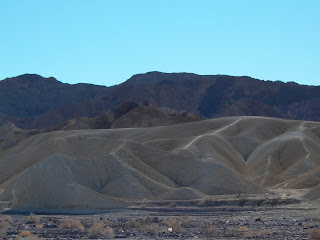In 1914 350 Chinese laborers and 150 mules built the Death Valley Railroad from Death Valley Junction to the new mine in Ryan. Because trestles had to be built and the heat was severe, it took 11 months to complete the 17 miles of track.
A trestle was built across this expanse. The mine tailings came later. One train a day ran taking in water for the miners and hauling colmanite (borax) ore out. 
 Working, eating and sleeping occupied almost all their time. This hillside is covered with remains of their living quarters. The walls were low. They put a tent or canvas tarp over the top and crawled inside to sleep. Most of these were large enough for only one man. Frequently we found a rock with wire wrapped around. This was how they kept the tents from blowing away.
Working, eating and sleeping occupied almost all their time. This hillside is covered with remains of their living quarters. The walls were low. They put a tent or canvas tarp over the top and crawled inside to sleep. Most of these were large enough for only one man. Frequently we found a rock with wire wrapped around. This was how they kept the tents from blowing away. We found none of the telltale bean cans found at other mine sites however there were innumerable tobacco cans.
We found none of the telltale bean cans found at other mine sites however there were innumerable tobacco cans.



 Working, eating and sleeping occupied almost all their time. This hillside is covered with remains of their living quarters. The walls were low. They put a tent or canvas tarp over the top and crawled inside to sleep. Most of these were large enough for only one man. Frequently we found a rock with wire wrapped around. This was how they kept the tents from blowing away.
Working, eating and sleeping occupied almost all their time. This hillside is covered with remains of their living quarters. The walls were low. They put a tent or canvas tarp over the top and crawled inside to sleep. Most of these were large enough for only one man. Frequently we found a rock with wire wrapped around. This was how they kept the tents from blowing away. We found none of the telltale bean cans found at other mine sites however there were innumerable tobacco cans.
We found none of the telltale bean cans found at other mine sites however there were innumerable tobacco cans.


This is the only larger building. We're guessing the cook shack - maybe the advent of Chinese Take-Out? Or an office or....






An interesting story has surfaced since exploring Sperry Wash and reading the available history of the 12 miles of rail in Amargosa Canyon. A crew of 100 Japanese laborers only lasted a few weeks in the heat. An account reads that when the author visited he saw just 17 laborers of which only 8 were wielding picks and axes. The other 9 were spraying those workers with water to keep them from overheating. The method? They filled their mouths with water and sprayed. While not hygienic, it may have saved lives.


 More of the wonderful desert colors.
More of the wonderful desert colors.






 Weather has been moving our way for the past couple of hours. A light mist is beginning as we get back to the highway.
Weather has been moving our way for the past couple of hours. A light mist is beginning as we get back to the highway.



































